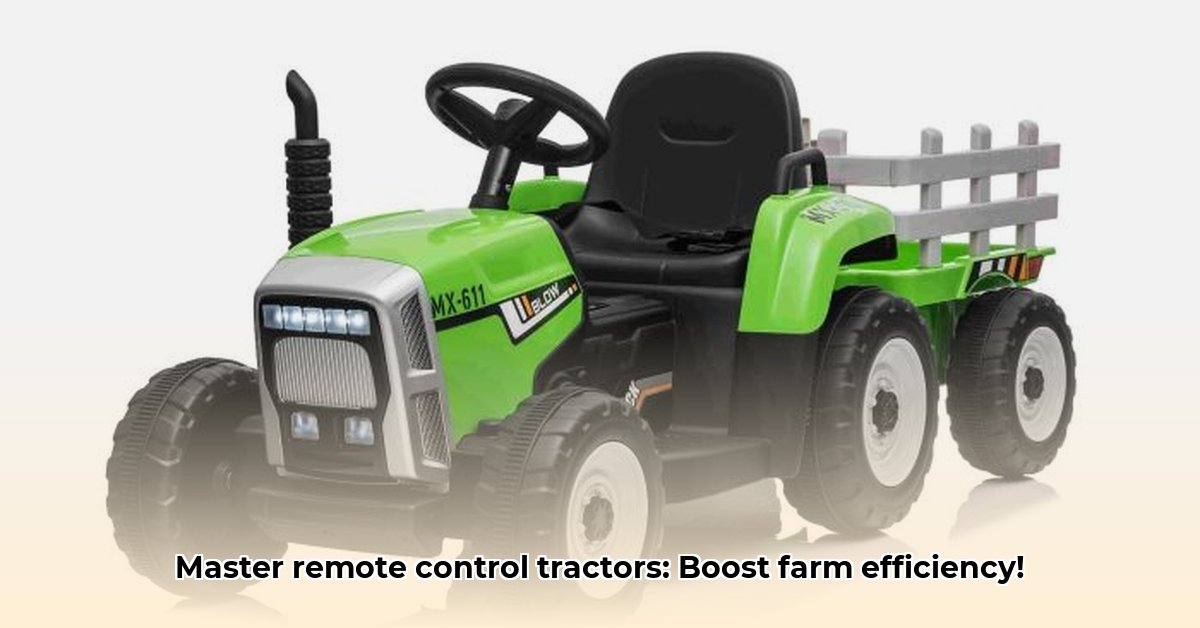
Remote-controlled ride-on tractors are revolutionizing land management, offering increased efficiency and safety across various applications. From large-scale farming to smaller-scale gardening, these machines provide a powerful and convenient solution. But with a growing market of diverse models, understanding the nuances of these innovative tools is crucial. This guide will equip you with the knowledge to navigate the world of ride-on remote control tractors, helping you choose the right model and maximize its potential. For more information on the cost of tractors, see tractor costs.
Understanding the Technology Behind Remote Control Tractors
Forget the image of a farmer wrestling with a traditional tractor – these machines combine robust tractor capabilities with the precision and convenience of remote control operation. This is achieved through a sophisticated wireless control system that allows for precise steering, implement control (like plowing or tilling), and various other functions from a safe distance. Think of it as driving a powerful machine from the comfort of a nearby seat, avoiding the noise, vibrations, and physical strain associated with traditional operation.
Choosing the Right Ride-On Remote Control Tractor: Key Features and Considerations
The market offers a wide array of models, each designed for different scales and tasks. Before making a purchase, carefully consider these factors:
Power and Engine: The horsepower rating directly impacts the tractor's ability to handle challenging terrains and heavy-duty implements. Higher horsepower often equates to greater capability but comes with a higher price tag. Do you need the power to tackle rocky terrain or will a lower-horsepower option suffice for your needs?
Control System: A reliable and responsive control system is paramount. Look for features like a wide signal range, responsive controls, and robust emergency stop mechanisms. Different models offer varying control options, such as joysticks or traditional steering wheel setups – choose the one most comfortable and intuitive for you.
Implement Compatibility: The tractor’s utility depends on its ability to work with your necessary implements. Check compatibility with plows, tillers, mowers, and any specialized tools for your specific tasks. Is the tractor compatible with the specific implements you require for your operation?
Safety Features: Prioritize safety features such as automatic braking systems, multiple shutoff options, and clear visual indicators of the tractor's operational status. What safety features are non-negotiable for your operation, and which models offer them?
GPS and Automation: Advanced models incorporate GPS guidance for precise operation and even automated functions like steering and implement control. This can significantly enhance efficiency and reduce operator fatigue. Will the precision and automation of GPS-guided models improve your workflow?
Model Comparison: A Quick Overview
The following table provides a simplified comparison of hypothetical models. Actual models and specifications will vary widely based on manufacturer and features.
| Model | Engine HP | Control Type | Implement Compatibility | Price Range (USD) | GPS/Automation |
|---|---|---|---|---|---|
| Model A | 20 | Joystick | Plow, Tiller, Mower | $10,000 - $15,000 | No |
| Model B | 40 | Steering Wheel | Extensive, Customizable | $20,000 - $30,000 | No |
| Model C | 60 | Joystick, GPS | Extensive, Automated | $35,000 - $50,000 | Yes |
Operating Your Remote Control Tractor: A Step-by-Step Guide
Operating these machines requires careful attention and adherence to safety protocols. Follow these steps:
Pre-Operation Checklist: Thoroughly inspect the tractor for any damage, check the battery level, confirm wireless connection, and verify the functionality of all controls.
Control Familiarization: Practice operating the controls in a safe, open area before engaging in any serious work. Become fully comfortable with steering, throttle, and implement controls.
Starting and Operation: Adhere strictly to the manufacturer's instructions for starting and operating the tractor. Use the remote to maneuver the machine smoothly and deliberately.
Implement Usage: Attach and operate implements according to the manufacturer's guidelines. Regularly monitor progress and adjust as needed.
Prioritizing Safety: Maintain clear line of sight, be aware of surroundings and potential hazards, and utilize all available safety features. Stop operation immediately if any issues arise.
Post-Operation Maintenance: Clean the tractor and inspect for damage after each use. Consistent maintenance ensures long-term reliability and safety.
Weighing the Pros and Cons: Is a Remote Control Tractor Right for You?
Before investing, carefully weigh the advantages and disadvantages:
Advantages:
- Enhanced Safety: Operate from a safe distance, reducing the risk of injuries.
- Improved Efficiency: Complete tasks more quickly and precisely.
- Reduced Operator Fatigue: Eliminate the physical strain of traditional tractor operation.
- Increased Accuracy: GPS-guided models offer exceptional precision for tasks like planting and spraying.
- Accessibility: Makes land management accessible to individuals with physical limitations.
Disadvantages:
- Higher Initial Cost: Remote-controlled models are generally more expensive than their traditional counterparts.
- Technical Complexity: Requires a certain level of technical understanding and familiarity with the control system.
- Potential Signal Interference: The wireless connection may be susceptible to interference, potentially disrupting operation.
- Specialized Maintenance: May necessitate more specialized maintenance compared to traditional tractors.
- Limited Range: Wireless signals have inherent range limitations.
The Future of Remote-Controlled Tractors
The technology behind these machines is continually evolving. Expect future advancements in control systems, increased automation, enhanced implement versatility, improved safety systems, extended operating ranges, and seamless integration with precision agriculture technologies. These advancements hold massive potential for transforming farming and land management, paving the way to even greater efficiencies and innovations.
This guide provides a foundation for understanding and utilizing remote-controlled ride-on tractors. Remember to meticulously research specific models and consult manufacturer instructions to ensure safe and effective operation.